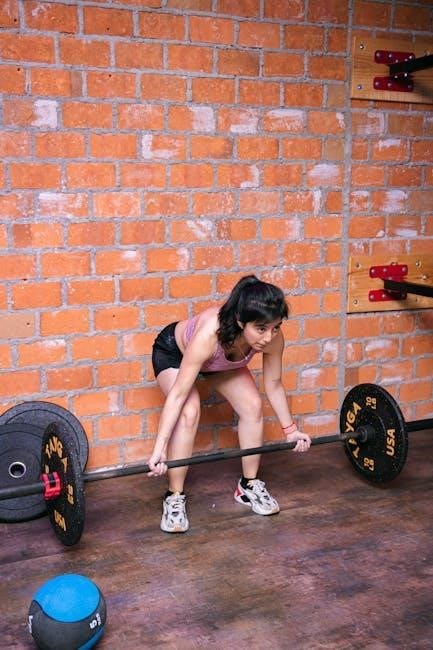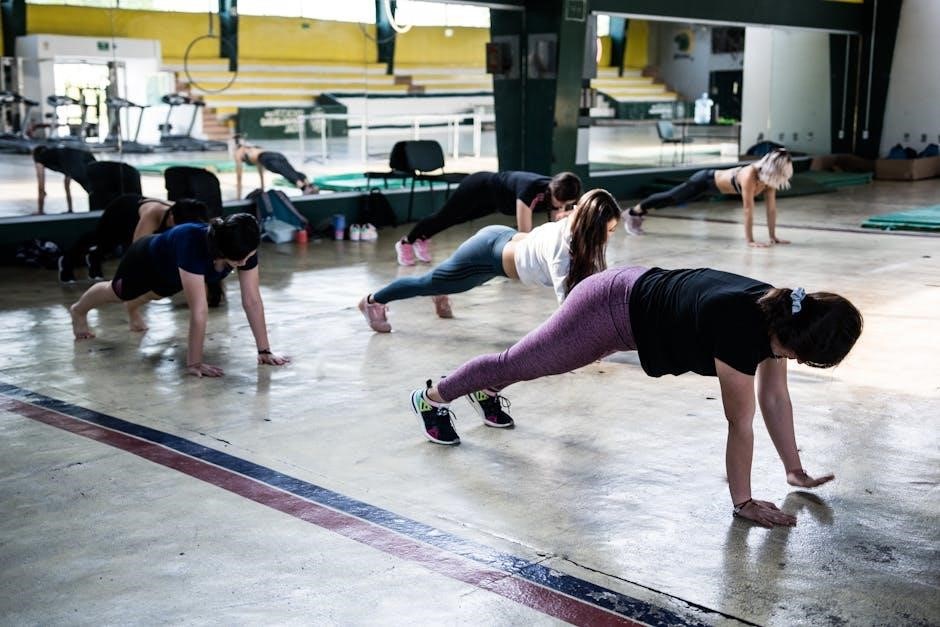Kegel exercises are simple pelvic floor muscle exercises benefiting men’s bladder control and sexual health. Developed by Dr. Arnold Kegel in the 1940s, they enhance urinary retention and overall pelvic strength through targeted contractions. A non-invasive, accessible solution for improving urological health.
What Are Kegel Exercises?
Kegel exercises are simple, non-invasive muscle exercises targeting the pelvic floor muscles, specifically the pubococcygeus muscle. Developed by Dr. Arnold Kegel in the 1940s, they involve voluntarily contracting and relaxing these muscles to improve pelvic floor strength; These exercises are beneficial for both men and women, focusing on enhancing bladder control and sexual function. By strengthening the pelvic muscles, Kegel exercises help improve urinary retention and overall pelvic health. They are easy to perform, require no equipment, and can be done discreetly anywhere. Regular practice promotes better muscle tone and functionality, making them a highly recommended practice for maintaining urological and sexual health in men.
History and Development of Kegel Exercises
Kegel exercises were developed in the 1940s by Dr. Arnold Kegel, an American gynecologist, to address women’s urinary incontinence post-childbirth. Initially focusing on female pelvic floor muscles, the exercises aimed to strengthen the muscles supporting the uterus, bladder, and rectum. Over time, their benefits extended to men, particularly for improving bladder control and sexual health. The exercises involve contracting and relaxing the pubococcygeus muscle, enhancing pelvic floor strength. Dr. Kegel’s innovative approach revolutionized pelvic floor rehabilitation, offering a non-invasive solution. Today, Kegel exercises are widely recommended for both genders, aiding in urinary retention, sexual function improvement, and overall pelvic health, making them a cornerstone in physical therapy and urology.

Benefits of Kegel Exercises for Men
Kegel exercises improve bladder control, enhance sexual function, and strengthen pelvic floor muscles. They boost core strength, posture, and athletic performance, offering holistic benefits for men’s health and wellness.
Improved Bladder Control and Urinary Continence
Kegel exercises significantly enhance bladder control by strengthening the pelvic floor muscles, which play a crucial role in maintaining urinary continence. Regular practice helps men manage stress incontinence and post-prostate surgery incontinence. By targeting the pubococcigeal muscle, these exercises improve the ability to hold urine longer, reducing leakage and urgency. This leads to better overall bladder function and confidence in daily activities. Strengthening these muscles also supports long-term urinary health, making Kegel exercises a non-invasive and effective solution for men seeking to improve their urological well-being. Consistency in performing these exercises ensures sustained benefits and enhanced quality of life.
Enhanced Sexual Function and Performance
Kegel exercises for men can significantly improve sexual function and performance by strengthening the pelvic floor muscles. These muscles, including the pubococcigeal muscle, play a key role in sexual arousal and ejaculation control. Regular practice enhances blood flow to the genital area, improving erectile function and increasing sensitivity. Additionally, Kegel exercises help men achieve better control over ejaculation, addressing issues like premature ejaculation. Strengthening these muscles also boosts overall sexual confidence and performance, leading to a more satisfying intimate experience. By incorporating Kegel exercises into their routine, men can experience these benefits and improve their sexual health effectively. This makes Kegel exercises a valuable addition to any man’s health regimen.

How to Perform Kegel Exercises
Kegel exercises involve contracting and releasing the pelvic floor muscles, similar to stopping urine flow. Perform 10-15 repetitions, 3-4 times daily, focusing solely on pelvic muscles without abdominal strain.
Identifying the Correct Muscles
Identifying the correct muscles for Kegel exercises is essential for effectiveness. Men can locate the pelvic floor muscles by stopping the flow of urine mid-stream, which engages the pubococcygeus muscle. This muscle is part of the pelvic floor and plays a key role in bladder control and sexual function. To ensure accuracy, men should focus on the sensation of squeezing without using abdominal or buttock muscles. Proper identification prevents incorrect muscle engagement and maximizes exercise benefits. Regular practice helps in isolating these muscles effectively, leading to improved bladder control and enhanced sexual performance. Consistency is key to achieving long-term benefits.
Step-by-Step Guide to Performing Kegel Exercises
To perform Kegel exercises, start by sitting comfortably or standing with knees slightly apart. Engage the pelvic floor muscles by squeezing as if stopping urine flow. Hold for 5-10 seconds, then release for 10 seconds. Repeat this cycle 10-15 times per session. Focus on isolating the pelvic muscles without tensing the abdomen or buttocks. Practice 3-4 sessions daily for optimal results. Breathe naturally throughout the exercise to avoid muscle tension. Over time, gradually increase the duration and frequency to strengthen pelvic floor muscles effectively.

Best Routines for Kegel Exercises
Aim for 3 daily sets of 10-15 contractions, holding each for 5-10 seconds. Gradually increase intensity and duration to build pelvic floor strength effectively.
Recommended Daily Exercise Plan
A daily Kegel exercise plan for men involves 3 sets of 10-15 contractions. Start by contracting the pelvic muscles for 5 seconds, then release for 5 seconds. Gradually increase hold time to 10 seconds as strength improves. Perform one set in the morning, one in the afternoon, and one before bed. Consistency is key for optimal results. For best outcomes, focus on proper muscle engagement without using abdominal or thigh muscles. Quality of contractions is more important than quantity. Over time, you can incorporate variations like quick contractions or endurance holds to further strengthen pelvic floor muscles.
Progressive Overload and Increasing Difficulty
Progressive overload involves gradually increasing the intensity of Kegel exercises to continue strengthening pelvic floor muscles. Start with 5-second contractions, then gradually extend to 10 seconds as muscle strength improves. Increase difficulty by adding more repetitions or sets over time. For advanced routines, incorporate variations like quick contractions (1-2 seconds) or endurance holds (up to 20 seconds). Additionally, try contracting against resistance or alternating between short and long holds to challenge the muscles further. This approach ensures continuous improvement and prevents plateaus. Always prioritize proper technique to avoid strain and maximize benefits.

Common Mistakes to Avoid
- Overusing abdominal muscles instead of targeting pelvic floor muscles.
- Incorrect breathing techniques that strain surrounding muscles.
Overuse of abdominal Muscles
Overuse of Abdominal Muscles
One common mistake while performing Kegel exercises is overactivating the abdominal muscles. This occurs when individuals mistakenly engage their abs instead of focusing solely on the pelvic floor muscles. Overuse of abdominal muscles can lead to ineffective contractions and strain on the lower back. To avoid this, men should focus on isolating the pelvic floor muscles by gently squeezing them without tensing the stomach or buttocks. Proper breathing is essential—inhale naturally and avoid holding your breath. If abdominal muscles are unintentionally engaged, pause and restart the exercise with a relaxed posture. Consistency and mindfulness are key to mastering the technique and avoiding this error.
Incorrect Breathing Techniques
Incorrect breathing is a common mistake during Kegel exercises that can reduce their effectiveness and cause discomfort. Holding your breath or breathing too deeply can lead to tension in unrelated muscles, such as the chest or shoulders, which disrupts the focus on the pelvic floor. Proper breathing involves inhaling naturally and exhaling slowly without forcing the breath. Avoid holding your breath during contractions, as this can increase pressure on the abdominal cavity and lead to strain. Instead, synchronize your breathing with the exercises—inhale during relaxation and exhale during muscle contraction. Maintaining a relaxed, natural breathing pattern ensures that the pelvic floor muscles are engaged correctly and effectively.

Kegel Exercises for Specific Needs
Kegel exercises are tailored for men with specific health conditions, such as post-prostate surgery recovery or premature ejaculation. They help regain bladder control and enhance sexual performance effectively.

Kegel Exercises After Prostate Surgery
Kegel exercises are highly recommended for men after prostate surgery to strengthen pelvic floor muscles and improve urinary control. These exercises help regain bladder control, reduce incontinence, and enhance recovery. By targeting the pubococcygeal muscle, they support pelvic stability and prevent post-surgery complications. Regular practice can restore confidence and improve quality of life. Starting with short contractions and gradually increasing duration is effective. Consistency is key to achieving long-term benefits and minimizing urinary leakage. Consulting a healthcare provider ensures personalized guidance for optimal results.
Kegel Exercises for Premature Ejaculation
Kegel exercises can be highly effective in managing premature ejaculation by strengthening the pelvic floor muscles, particularly the pubococcygeal (PC) muscle. This muscle plays a crucial role in controlling ejaculation. By practicing regular Kegel exercises, men can improve their ability to delay ejaculation and enhance sexual performance. The exercises involve contracting and holding the PC muscle for several seconds, then releasing. Consistency is key, as improved control often develops over time. These exercises are a natural, non-invasive solution supported by medical professionals to address premature ejaculation and boost sexual confidence. Regular practice can lead to significant improvements in ejaculatory control and overall sexual satisfaction.

Combining Kegel Exercises with Other Practices
Combining Kegel exercises with pelvic floor physical therapy enhances bladder control and sexual function. Integrating them into daily workouts improves core strength and overall posture naturally.
Pairing with Pelvic Floor Physical Therapy
Pelvic floor physical therapy complements Kegel exercises by addressing muscle imbalances and improving bladder control. A physical therapist can create personalized treatment plans tailored to individual needs.
Techniques like biofeedback and manual therapy enhance muscle awareness and strength. This combination strengthens pelvic muscles more effectively than Kegel exercises alone, improving urinary continence and sexual function.
Integrating Kegel Exercises into Daily Workouts
Incorporating Kegel exercises into daily routines enhances core strength and overall fitness. They can be done during other workouts, such as while doing push-ups or squats, to improve posture and pelvic stability.
Consistency is key; even a few minutes daily can yield significant benefits. This integration supports athletic performance and reduces injury risk, making it a practical addition to any exercise regimen.
Monitoring Progress and Results
Monitoring progress involves tracking exercise consistency and observing improvements in symptoms like bladder control and sexual performance over time. Regular practice yields measurable results.
Tracking Exercise Consistency and Quality
Consistency is key to seeing results from Kegel exercises. Men should track their daily routine, noting the number of repetitions and sets completed. Quality is equally important; ensure proper muscle engagement without straining. Using a journal or app to log progress helps maintain accountability. Over time, improvements in bladder control, sexual function, and overall pelvic strength can be observed. Gradually increasing the difficulty of exercises, such as holding contractions longer, can enhance results. Regular tracking allows individuals to identify patterns and adjust their routine for better outcomes, ensuring long-term benefits like improved urinary retention and sexual performance.
Measuring Improvements in Symptoms
Improvements from Kegel exercises can be measured by observing reductions in urinary leakage, enhanced bladder control, and stronger pelvic floor muscles. Men may notice fewer incidents of incontinence, better control over urination, and improved sexual performance. Over time, consistent practice leads to noticeable benefits, such as increased endurance and reduced symptoms of premature ejaculation. Tracking these changes helps men understand the effectiveness of their routine. For example, if urinary leakage decreases or ejaculatory control improves, it indicates progress. Regular monitoring allows individuals to adjust their exercises for optimal results, ensuring continued improvement in pelvic health and overall well-being through non-invasive, effective muscle strengthening.

Additional Benefits of Kegel Exercises
Beyond bladder control, Kegel exercises enhance core strength, improve posture, and reduce lower back pain by stabilizing pelvic floor muscles, benefiting overall physical stability and reducing injury risks.
Core Strength and Posture Improvement
Kegel exercises significantly contribute to core strength by targeting the pelvic floor muscles, which act as a foundation for the entire core. Strengthening these muscles enhances stability and balance, reducing the risk of injuries during physical activities. Improved core strength also supports better posture by stabilizing the pelvis and lower back, which are essential for maintaining proper spinal alignment. Over time, consistent practice can reduce slouching and alleviate lower back pain, promoting a more upright and confident stance. Additionally, stronger pelvic floor muscles contribute to overall physical stability, making everyday movements more efficient and less strain-prone. This makes Kegel exercises a valuable addition to any fitness or rehabilitation routine.
Enhanced Athletic Performance
Kegel exercises play a pivotal role in enhancing athletic performance by strengthening the pelvic floor muscles, which are essential for core stability and overall physical balance. Stronger pelvic muscles improve posture, reduce injury risk, and enhance endurance during sports. Athletes benefit from better pelvic floor engagement, which optimizes energy transfer and movement efficiency. For example, runners and cyclists may experience improved performance due to enhanced core stability. Additionally, Kegel exercises promote faster recovery by stabilizing the pelvis and reducing muscle strain during high-intensity activities. Incorporating Kegel exercises into training routines can lead to better athletic results, making them a valuable addition to any fitness regimen. They complement traditional workouts, ensuring a strong, stable foundation for peak performance.

Resources for Kegel Exercises
Downloadable PDF guides, websites, and apps provide comprehensive routines, progress tracking, and expert advice for men. These resources offer structured plans to strengthen pelvic floor muscles effectively.
Downloadable PDF Guides for Men
Downloadable PDF guides provide structured routines and step-by-step instructions for men to perform Kegel exercises effectively. These guides include detailed diagrams, progress trackers, and expert tips to enhance pelvic floor strength. Many resources, such as “EJERCICIOS KEGEL PARA HOMBRES,” are available free of charge on platforms like uDocz. They cater to specific needs, including post-prostate surgery recovery and improving sexual function. These guides emphasize quality over quantity, ensuring exercises are performed correctly for maximum benefits. With customizable plans, men can integrate Kegel exercises into their daily routines seamlessly. These PDFs are invaluable tools for improving bladder control, sexual health, and overall pelvic floor wellness.
Recommended Websites and Apps
Several websites and apps offer comprehensive resources for men practicing Kegel exercises. Platforms like uDocz provide free downloadable PDF guides, while specialized apps deliver interactive tools for tracking progress. Websites such as strana.ru highlight the benefits of Kegel exercises for men, including improved bladder control and enhanced sexual performance. Additionally, apps like Kegel Trainer offer guided routines and reminders to ensure consistency. These digital resources are designed to educate and motivate users, making it easier to incorporate Kegel exercises into daily life. They often include expert advice, customizable plans, and detailed instructions, ensuring men can achieve the best results from their pelvic floor training.
